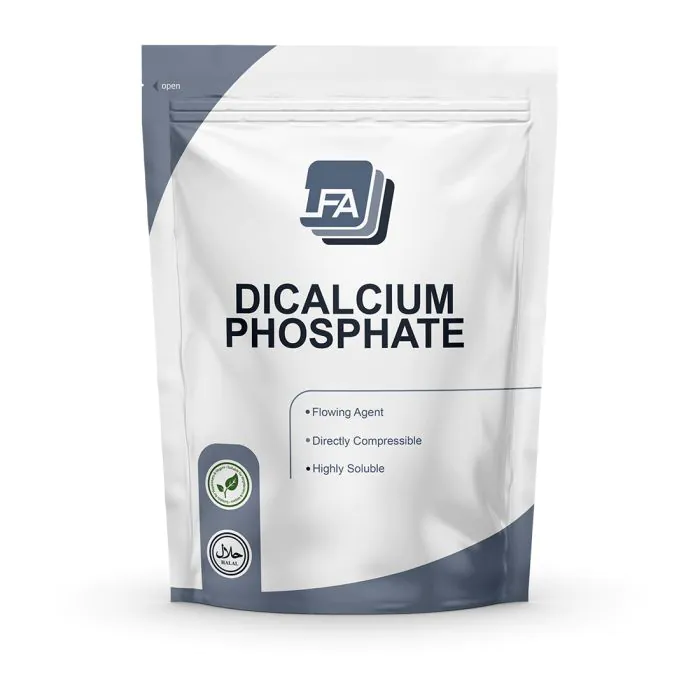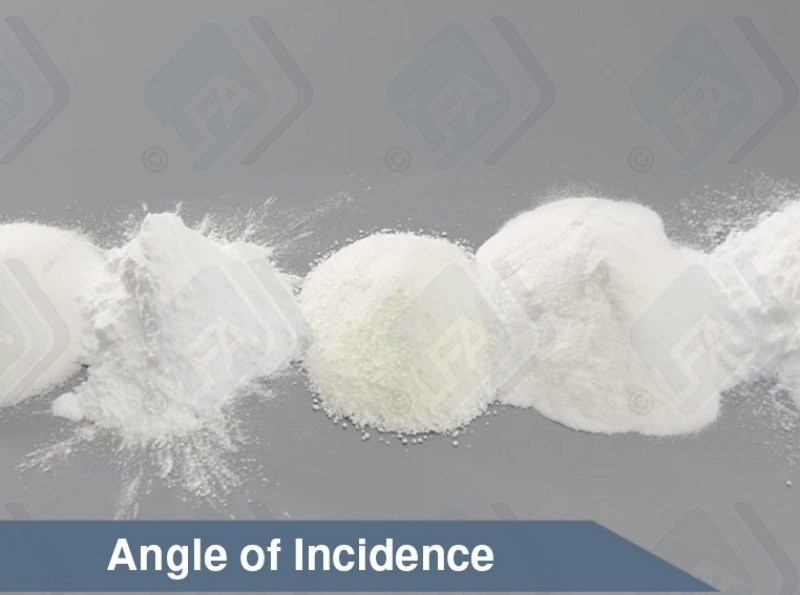Hydrogenfosforečnan vápenatý je složkou v řadě různých výrobků. Je používán v produkci tablet a kapslí jako „průtokové činidlo“. Hydrogenfosforečnan vápenatý je dostupný v mnoha různých velikostech balení. Hrubší zrna dodávané námi zaručují hladký průtok a nabízejí excelentní stlačitelnost.
Záruka hladkého průtoku (tekutost) je zásadním elementem výrobního procesu. Zaručuje tak, že vaše ingredience proběhne strojem lehce, bez možných zádrhelů. Navíc to také znamená, že vaše konečné produkty budou mít konzistentní obsah přísad v celém rozsahu. Tedy každá vámi vyrobená tableta bude stejná.
Komprese je jednoduchý proces, v kterém se prášek formuje do solidní tablety. LFA Hydrogenfosforečnan vápenatý je přímo stlačitelný. Používání přídavné látky jako je Hydrogenfosforečnan vápenatý redukuje úsilí vynakládané na vytvoření nových receptur.
Hydrogenfosforečnan vápenatý je vysoce rozpustný v kyselině citrónové a citronanu amonném. Hydrogenfosforečnan vápenatý má pH od 6,5 do 7. Díky své zásaditosti nepracuje s některými kyselými aktivními látkami. Tmelivé vlastnosti Hydrogenfosforečnanu vápenatého jsou pouze průměrné. Pro lepší tmelivé vlastnosti produktu je potřeba vedle Hydrogenfosforečnanu vápenatého použít také ještě další pomocnou látku.
Hydrogenfosforečnan vápenatý snadno projde zažívacím systémem. Má mnoho různých využití, sám o sobě také funguje jako doplněk stravy. Je také často obsažený v cereáliích, mouce a těstovinových produktech. Je používán jako prostředek proti spékání, protože obsahuje malé množství vlhkosti. Mimo jiné je zdrojem minerálního fosforu, který se často používá v biopotravinách. Další možností prominentního využití Hydrogenfosforečnan vápenatý je krmivo pro zvířata. Přispívá zvířecímu metabolismu a akceleruje růst a vývin.
Správné zacházení s tímto produktem je důležité z hlediska bezpečnosti a kvality produktu. Může totiž podráždit oči, pokud dojde k vzdechnutí, může způsobit lehkou nevolnost v oblasti hrudníku. Při zacházení s produktem byste měli používat ochranné brýle, rukavice a inhalační masku. Vždy uchovávejte Hydrogenfosforečnan vápenatý v uzavřené nádobě při mírné střední teplotě. Vyhýbejte se vlhkým a extrémním teplotním podmínkám. Nesprávné skladovaní produktu může časem ovlivnit tvrdost tablet.
Hydrogenfosforečnan vápenatý je efektivním průtokovým činidlem a svým složením se také podílí na živinách vašeho produktu. Může být přidán do mnoha jídel jako doplněk participující na zdravé stravě jak lidí, tak i zvířat. Fosfor a vápník ve stravě spotřebitele zlepšuje tělesné funkce v mnoha oblastech. Toto je produkt, který vaši zákazníci znají, a který perfektně funguje jako doplněk vašich tablet.
LFA Hydrogenfosforečnan vápenatý vám bude doručen ve formě krystalického prášku. Je sypký, bílý nebo špinavě bílý a je bez zápachu.
Are all excipients safe for all ages to consume?
Yes, it does not matter what age, size or sex the person consuming the products is. It is, however, important to check the intolerance data.
Are all the excipients safe for human consumption?
Yes, all of the excipients are safe for human or animal consumption. There are some precautions that should be taken when handling them and there are some people that might have intolerances to some of them. Information on this can be found in the products MSDS and Intolerance Data Sheet. This can be found in this section for every excipient.
Are there any known allergens or health risks?
Jsou vaše Pomocné látky přírodní?
Ano, všechny naše Pomocné látky jsou extrahovány z přírodních zdrojů. Pro více informací prosím navštivte jednotlivé stránky produktu.
Can I get a better price for excipients than is listed on the website?
Yes, we have bulk pricing for all of our excipients, and these can be found in this section. We offer bulk in 500 kg, 1 ton, 2 ton and 5 ton lots. The prices are set on these quantities as these are the amounts that will fit on pallets.
Can I have a CoA for my Excipient?
Yes. CoA stands for Certificate of Analysis this is also known some times as an MSDS (Material Safety Data Sheet) all of the information contained in a CoA is inside the MSDS for every LFA product which is emailed to you after purchase.
Mohu vyrábět tablety bez Pomocné látky?
Je nepravděpodobné, že budete moci vyrábět tablety bez použití jakýchkoli pomocných látek vůbec. Některé produkty, které se váží bez Pomocné látky, ale pak nejsou toku přes počítač. Doporučujeme, že budete používat
Dissolving rate? Any known factors that can affect the rate, speed up or slow down the breakdown of a tablet?
Yes. There are two things at play here. You can get hygroscopic and hydrophobic excipients. Hygroscopic means that they take on water quickly, while hydrophobic means that they repel water.
There are products know as supper disintegrants. These products help the breakdown of tablets. At the moment LFA does not sell any supper disintegrants.
Magnesium stearate is hydrophobic this means that it will slow the breakdown of a tablet.
However, it is used in such small amounts that most of the time it will not make a difference to our customer's products. If they would like to be sure then they should conduct what is known as a disintegration test.
Do any of the excipients increase the speed of damage to tooling? i.e. more granular?
Yes, Dicalcium Phosphate, if used in high amounts, will cause more damage to tooling than just Firmapress or MCC. However, there are not many situations in which this would be a good idea.
How long is the storage period of each excipient? What is the shelf life?
Firmapress - 2 years form batch date.
Dextrose - 3 years from batch date.
Dicalcium Phosphate - 3 years from batch date.
Microcrystalline Cellulose -
Magnesium stearate -
Lactose - 2 years from batch date.
Silica Dioxide - 2 years from batch date.
How should I clean contact parts that have come into contact with my excipients or active ingredients?
here are 6 steps that should be followed as a general rule of thumb when cleaning contact surfaces that have come into contact with powders:
Dry Clean - First you need to remove as much of the dry powder as possible. You can do this using a hover/vacuum. Make sure that the vacuum you are using has a filter good enough to handle fine dust.
Wet Clean - Next you need to perform a wet clean. This can be done with warm water and soap or if available an ultrasonic cleaner.
Rinse - Next you need to rinse off any soap with potable water (drinking water). You do not have to do this if you used an ultrasonic cleaner in the last step. It is important to ensure that all parts are thoroughly dried immediately after washing to avoid any rusting.
Sanitise - Next you need to sanitise the surface. This step is recommended by the FDA. There are a number of sanitising solutions available designed to be applied and left on.
Lubricate - You now need to lubricate any parts that require it. This should be with the appropriate grade oil or grease considering your use and greasing chart. Store - Finally store any of the parts in a cool dry place. If you are storing them on the machine then make sure the machine is in a temperature controlled environment with low humidity.
Jaký je rozdíl mezi řadou pomocných látek?
Nabízíme Mikrokrystalická Celulóza, Stearan Hořečnatý, Hydrogenfosforečnan Vápenatý a Firmapress v našem sortimentu z pomocných látek.
Mikrokrystalická Celulosa je pojivo, které drží obsah tablet dohromady.
Fosforečnan vápenatý je tekoucí agent a pomáhá přesunout složky prostřednictvím počítače dříve, než jsou komprimovány.
Magnesium-Stearát je suché mazivo a pomáhá znovu s pohybem surovin přes počítač, ale také pomáhá při vysunutí tablety z počítače. Vezměte prosím na vědomí, že Hořčík Sterate není vázán sám.
Firmapress je vše v jednom mix Mikrokrystalická Celulosa, Magnesium-Stearát a Fosforečnan vápenatý.
What is the mesh size of your excipients? etc.
Dextrose - approx 100 mesh
Dicalcium Phosphate - approx 100 mesh
Microcrystoline Cellulose - approx 120-200
Magnesium sterate -
Lactose - 80 mesh
Silica Dioxide -
Firmapress - 100-200 mesh
What kind of agent is each excipient?/ What is the main use of each excipient?
Dextrose - Sweetener, binding agent, good for chewable tablets or candy.
Microcrystalline Cellulose - Binder, filling agent. Good at binding tablets and making them bigger. It can also be used as a filler for capsules.
Magnesium stearate - Dry Lubricant. This stops products from getting stuck to the tooling. It can also help with powder flow issues and caking issues.
Lactose - Binder, sweetener and bulking agent. It has a large mesh so it flows well but most people do not like it because of the intolerance issues.
Silica Dioxide - Flowing agent. This assist powders in flowing smoothly through the machines. It also helps with cacking issues where powders get stuck to the machine.
What kind of condition should excipients be stored in?
Firmapress - 2 years form batch date.
Dextrose - 3 years from batch date.
Dicalcium Phosphate - 3 years from batch date.
Microcrystalline Cellulose -
Magnesium stearate -
Lactose - 2 years from batch date.
Silica Dioxide - 2 years from batch date.
Which excipient should I add if the product doesn't bind well?
If your product does not bind well then we would recommend using MCC. This can be used in any % the limiting factor is the size of the tablet.
If the amount of MCC you would have to use would be too much or if you do not want to use MCC then you have 3 other options: Ask your supplier for a directly compressible or tabletable grade of your product. Spray dry your product. Wet granulate your product.
Which excipient should I add if the product is sticky?
If your product is sticky then you will need to add a dry lubricant to your mix. For this, we recommend magnesium stearate.
We do not recommend that you add more than 1% to the mix as more than this can cause capping. If your product is still sticky at this point then we would recommend looking into granulation.
Which excipient should I add if the product/API is clumpy?
If your product or API is clumpy then you will need to add an anticaking agent. For this, we recommend silicon dioxide. We only recommend adding a maximum of 2% of this to the mix








